The Governor's Concluding Remarks for 2024
Ladies and Gentlemen,
Trade disputes and the ongoing conflicts are undermining confidence at the international level, casting a shadow over the global economic outlook. In recent weeks, the International Monetary Fund (IMF) downgraded its global growth projections for the next two years, to less than 3 per cent, well below the average recorded in past decades.
Concerns over a potential trade war intensified on 2 April, when the United States introduced sweeping tariff hikes, which were partly paused in the weeks that followed. The announcement sparked significant volatility in the financial markets, with firms most exposed to international trade hit hardest. Investors shifted towards assets that are considered safer, pushing the price of gold to new all-time highs.
Unlike in previous periods of uncertainty, the yields on long-term US Treasury bonds decreased and the dollar depreciated (Figure 1.a). This trend persisted in the weeks that followed, despite a partial easing of financial tensions and a rebound in stock prices. This raises important questions about the future structure of the international monetary system and the dominant role of the US dollar as both a reserve and a trade invoicing currency.1
We are witnessing deep fissures in the very equilibrium that has underpinned the global economy for decades. While the policies of the US administration are the primary trigger, they are part of an already rapidly changing landscape.
A global economy amid uncertainty and change
The current trade disputes are partly driven by growing discontent with globalization and disenchantment with the unfulfilled promises of free trade.
Since the great financial crisis, a widespread perception has taken hold in many advanced economies that globalization has exacerbated inequality and reduced employment opportunities for lower-skilled workers. In reality, these developments are largely a consequence of technological progress, as well as of distortions caused by unfair trade practices, such as the substantial subsidies granted by some emerging economies to their manufacturing sectors.
Meanwhile, many low-income countries remain trapped in poverty and burdened by high levels of debt, despite the opportunities presented by an integrated global economy and the financial aid provided by the international community. Discontent has grown among emerging economies - which have benefited greatly from trade liberalization2 - over the lack of recognition, within the governance of international institutions, of their increasingly important role in the global economy.
As a result, consensus around a framework based on shared rules, open markets, and multilateral cooperation has gradually weakened.
Against this backdrop, the protectionist policies adopted by the US reflect its declared aim of reviving domestic manufacturing and correcting trade imbalances, particularly vis-à-vis China.
The announcement of high tariffs, it would appear, is being used as a bargaining tool to redefine international economic and political relations. However, the effects of this strategy are difficult to predict and manage.
Although the tariffs currently in force in the US are lower than those announced in early April, they are the highest since the Second World War and are causing a notable increase in average tariffs worldwide (Figure 1.b).
Figure 1
Exchange rate and tariffs in the US
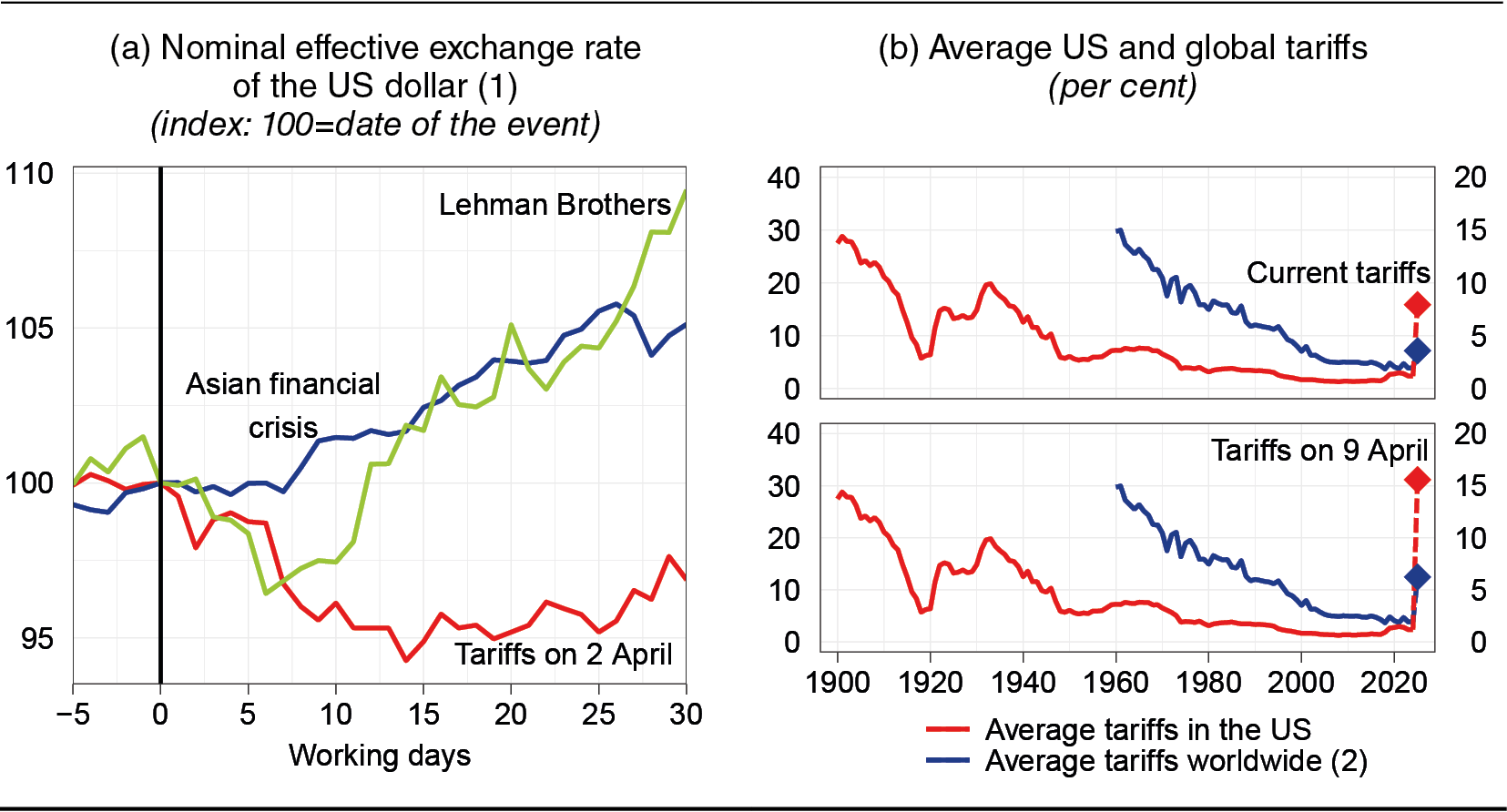
Sources: For panel (a), based on LSEG and Intercontinental Exchange data; for panel (b), see the sources for Figures 14.2 and 14.7 in Chapter 14 of the Annual Report for 2024, 2025.
(1) The figure shows developments in the effective exchange rate of the US dollar in the 30 days following the outbreak of the Asian financial crisis, the collapse of Lehman Brothers and the tariff announcement on 2 April 2025. An increase in the index indicates an appreciation of the US dollar against a basket of currencies. - (2) Right-hand scale.
Their potential impact is now significantly greater than in the past, owing to the close integration of the global economy.
The higher trade barriers could shave nearly 1 percentage point off global growth over a two-year period.
The estimated impact on the US economy would be roughly double that. The tariffs could lead to lower labour demand and heightened inflationary pressures, at a time when inflation expectations are already rising. They are also weighing on household and business confidence, with potential repercussions on consumption and investment.
The stream of announcements, retractions and revisions is fuelling uncertainty and volatility in the markets. These conditions risk amplifying the effects of the tariffs and could persist for some time, given the complexity of trade negotiations, which typically take far longer than the 90-day suspension announced.
Higher trade barriers are unlikely to correct the large US trade deficit, which mainly reflects imbalances driven by strong domestic demand in an economy close to full employment. A correction would require reducing consumption or investment, which would be accompanied by lower inflows of foreign capital.3
The medium-term effects of the tariffs on the global economy will depend on the ability of countries and firms to redirect international trade and forge new trade relations. Chinese firms, for example, are expanding their presence abroad by leveraging technological advantages and adopting aggressive pricing policies to absorb excess capacity.
Protectionist policies are steering the global economy onto a perilous course. The tariffs currently in effect could reduce international trade by around 5 per cent, prompting a reconfiguration of global supply chains. This would lead to less integrated and less efficient trading systems.
The effects risk spilling over beyond trade, altering the structure of the international monetary system, currently centred on the US dollar, and restricting capital flows.
They could go further still, hampering the movement of people, ideas and knowledge. Weaker global cooperation, including in science and technology, would ultimately reduce incentives for innovation and hinder progress. Over time, the very foundations of shared prosperity would be compromised.
Yet perhaps the most far-reaching risk lies elsewhere: that trade, once a driver of integration and dialogue, becomes a source of division, fuelling political instability and endangering peace.
The globalization of services
Somewhat surprisingly, current trade disputes continue to revolve around goods trade, despite the growing role of services in the global economy. The United States has a large surplus in this sector, including with the European Union, especially in digital services (Figure 2.a).
Since the global financial crisis, international trade in services has grown faster than trade in goods (Figure 2.b), reaching 15 per cent of world GDP, one quarter of total trade and one third of transactions within global supply chains. Even within trade in goods, the share attributable to services - such as marketing, design and after-sales support - accounts for a growing portion of value added.
Figure 2
Trade in goods and services
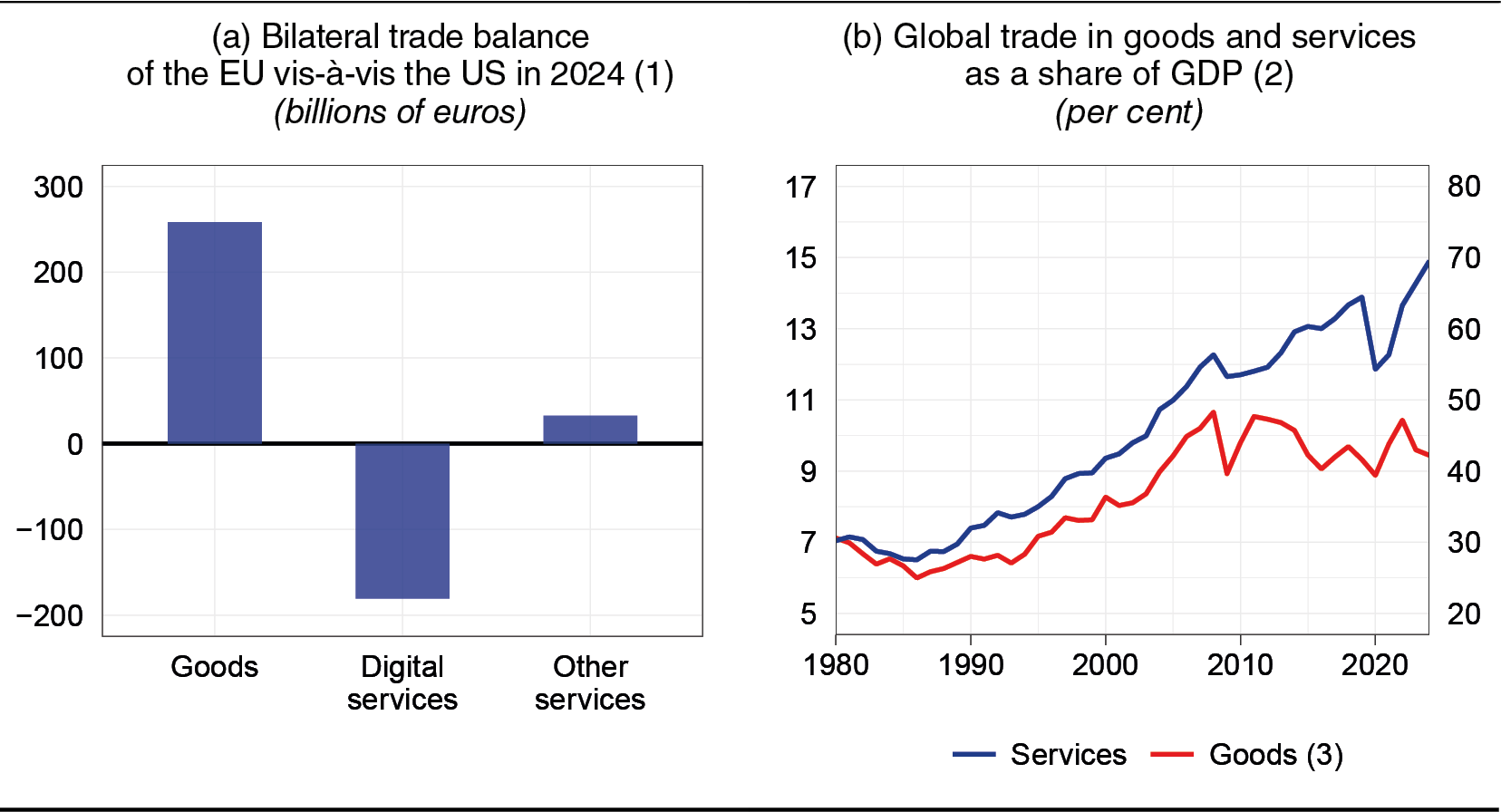
Sources: Eurostat and IMF, World Economic Outlook, April 2025.
(1) A negative value indicates an EU deficit and a US surplus. - (2) Sum of imports and exports. - (3) Right-hand scale.
The main driver of this expansion has been digitalization, which has made it easier to provide services remotely.4 Over the last twenty years, trade in digital services has grown at an average annual rate of 8 per cent, twice as fast as traditional services such as tourism and transportation.
As was the case for goods in the past, trade in services may prove to be a powerful engine of productivity growth,5 helping to narrow gaps between countries and contain inflation. However, for this transition to be sustainable, it must be combined with social protection systems and targeted investment in human capital, so as to safeguard the workers most exposed to technological change.
Insidious risks are inherent in the concentration of power in a few large global corporations which steer technological innovation, control vast troves of data and threaten competition. The combined market value of the seven leading US tech companies today exceeds $15 trillion. Given this scenario, effective regulation that protects consumer rights, media plurality and competition - without stifling innovation - is essential.
Global public debt
Over the last fifteen years, the global debt-to-GDP ratio has risen significantly, with a marked acceleration in the two largest world economies (Figure 3).
Figure 3
Public debt in the main economic areas
(per cent of GDP)
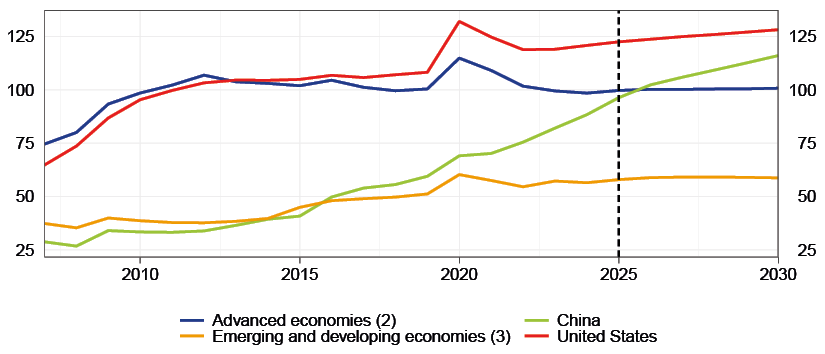
Source: IMF.
(1) The data from 2025 onwards are forecasts. - (2) Excludes the United States. - (3) Excludes China.
This trend partly reflects the series of global shocks - from the 2008 financial crisis to the pandemic and the energy crisis - that have disrupted economic activity and necessitated extraordinary government intervention.
The high level of debt exposes economies to volatility in sovereign debt markets and limits the room for manoeuvre in the event of a crisis.
Low-income economies face severe tensions.6 In just over 15 years, their debt-to-GDP ratio has doubled and debt servicing costs have soared, diverting crucial resources from growth and development.7 More than half of these countries are currently in a highly vulnerable position,8 and a significant share of their debt is due to mature in the next two years.
A larger share of this debt is now held by foreign creditors. Alongside multilateral institutions and the governments of advanced countries, new actors, such as China and a growing number of private investors, have come to the fore. Such a diverse pool of creditors, compounded by the deterioration in international relations, makes it more difficult to find shared solutions and to manage potential crises in a coordinated way.
It is crucial to strengthen the G20's Common Framework for restructuring the debt of low-income countries, which has been little used so far because of procedural obstacles. We need more effective cooperation between stakeholders, so as to overcome the challenges posed by disagreements between countries. Although the debt of low-income countries accounts for just a small share of the world economy, reducing it is essential, not only to limit global financial risks, but above all to create prospects for prosperity for more than one billion people.
Lowering the debt-to-GDP ratio is also key for the advanced economies in order to free up resources for development. This requires policies that can boost growth through reforms, innovation and education. At the same time, it is essential to embark on a path of fiscal consolidation that is both credible and gradual: credible, to bolster confidence in the sustainability of public finances; gradual, to prevent setbacks to growth and head off unacceptable social costs.
Equity is critical to the success of any reform strategy. Without social consensus, no fiscal policy is sustainable in the long term.
The economic outlook and monetary policy in the euro area
The real economy and inflation
After a long period of stagnation, the euro-area economy returned to growth in 2024, though at a rate below its potential.9 Once again, Germany failed to provide its decisive contribution.
Domestic demand remained below expectations, despite some signs of recovery. The fallout from the energy crisis, the still restrictive monetary policy stance and the widespread uncertainty dampened consumption and investment, which was affected by the weakness of the manufacturing sector.
The support from foreign demand also faltered, reflecting the deterioration in the global economy.
In the first quarter of this year, GDP rose by 0.3 per cent. Industrial production, while showing signs of stabilization, remains well below the levels recorded prior to the energy crisis, especially in Germany and Italy.
In this context, the return of inflation to close to 2 per cent is a positive sign (Figure 4.a). This is partly due to wage pressures easing: the recovery in real wages is well on track and new contracts provide for significantly smaller increases than in the past two years.
Figure 4
Economic activity and prices in the euro area
(year-on-year percentage changes)
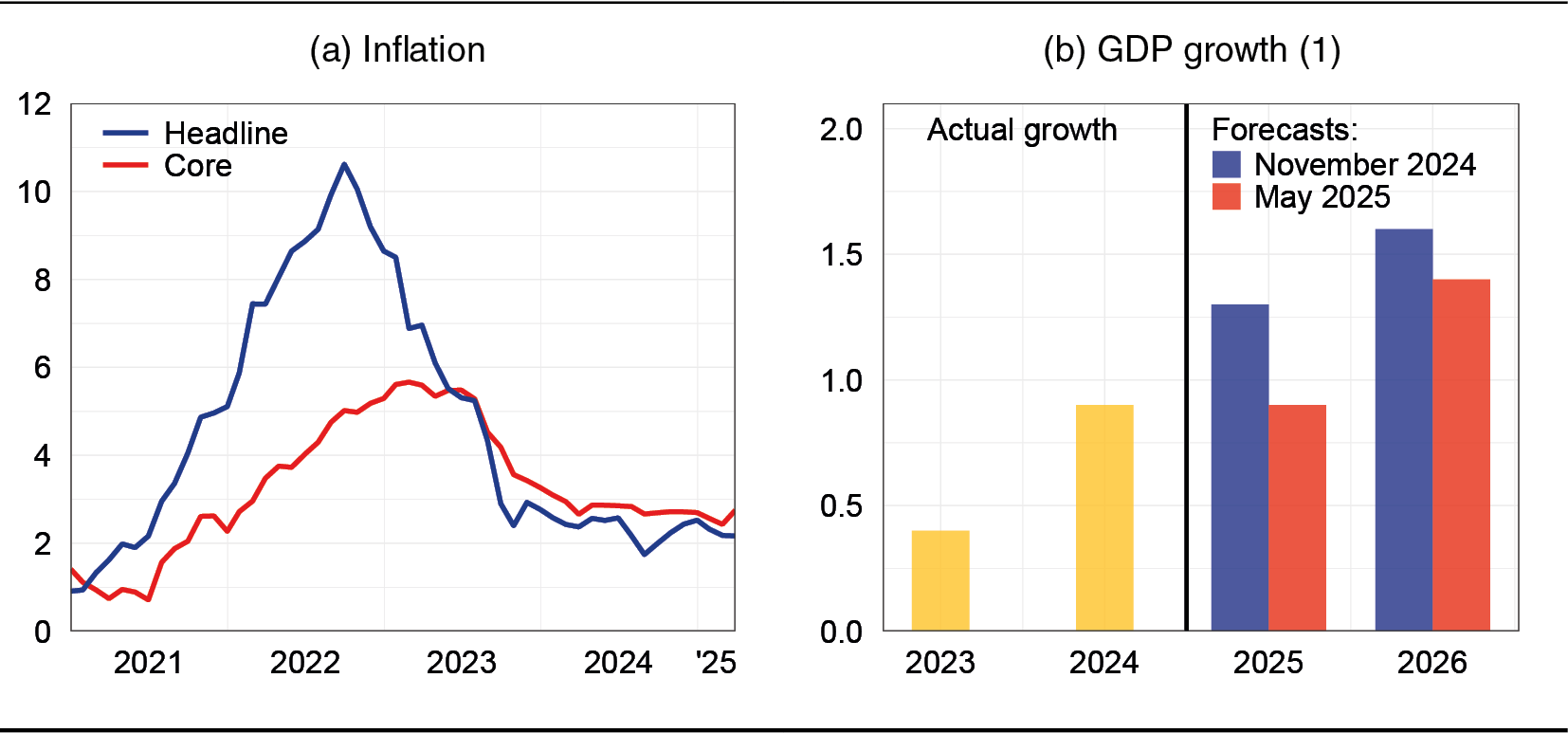
Sources: European Commission and Eurostat.
(1) For GDP growth forecasts, see European Commission, European Economic Forecast, November 2024 and May 2025.
Outlook and risks
Protectionist policies loom over the fragile recovery outlook. The outcome of trade negotiations is uncertain, but the impact on the European economy is bound to be significant.
The United States is the main outlet market for euro-area products, absorbing almost one fifth of exports. Some of the sectors most exposed to tariffs - such as transport equipment, machinery and beverages - are already showing signs of declining confidence, weakening order expectations and deteriorating employment prospects.
Tariff barriers could also reduce demand for European products indirectly by holding back the global economy. In addition, China and some South-East Asian countries, which all have excess production capacity and large trade surpluses with the US, are likely to seek new outlets to counter the effect of the tariffs, thus exacerbating competitive pressures on European markets.
Uncertainty about trade policies hinders business planning and raises firms' borrowing costs. Following the April announcements, European equities fell sharply, amid rising volatility and widening credit and liquidity risk premiums.
Tensions have since subsided and have not affected financial stability, thanks to the soundness of the European banking system and to the improvement in the public finances of vulnerable countries. However, investor confidence is still wavering.
In recent weeks, the IMF and the European Commission have cut their growth forecasts for the next two years by about half a percentage point (Figure 4.b).
On the inflation front, energy prices have fallen considerably and the euro has strengthened. Together with weak economic growth and intense global competition, these developments could dampen consumer price inflation. Market expectations point to inflation returning to below 2 per cent as early as the second half of this year and decreasing to 1.7 per cent on average in 2026.
This is an unsettled economic outlook.
A further appreciation of the euro, growing uncertainty or tighter financial conditions could magnify the recessionary impact of the tariffs. Moreover, a larger-than-expected increase in Chinese exports to Europe could push down production and inflation.10
Conversely, swift and tangible progress in trade negotiations would mitigate downside risks to economic activity. The anticipated increase in public spending in Europe could support growth, with the effects appearing gradually over time. Disruptions to global supply chains would put upward pressure on inflation.
Monetary policy
Past concerns about the disinflation process have proved unfounded.
The credibility of the European Central Bank's action has kept expectations anchored to the 2 per cent target, preventing the recovery in real wages from triggering the feared wage-price spiral. Core inflation has declined at a pace consistent with past experience, while persisting somewhat in services. Even the 'last mile' has not proved particularly challenging so far.11
On the whole, disinflation has not taken too high a toll on the economy and is now close to completion. The cuts in the ECB's key interest rate, amounting to 1.75 percentage points over the past year, are feeding into financial conditions and will support economic activity over the next few months.
Charting the course of monetary policy in the coming months will be far from easy.
Decisions will have to be assessed on a case-by-case basis, weighing up available data and the outlook for inflation and growth.
The previous cuts clearly leave less room for reducing interest rates further. However, the macroeconomic outlook remains weak and trade tensions could cause it to deteriorate, though it is hard to say how and when that might play out.
It will be essential to maintain a pragmatic and flexible approach,12 while closely monitoring liquidity conditions and signals from financial and credit markets.
The ECB Governing Council has already proved able to act decisively and swiftly to safeguard monetary and financial stability, and will continue to do so in the future.
The European Union: rethinking the growth model
The European economy is showing clear structural weaknesses. Stagnating productivity and lagging innovation are curbing its growth potential. Its dependence on foreign markets, both in acquiring supplies and in selling its products, makes it more vulnerable in an increasingly fragmented global environment. We need to rethink the growth model that has supported Europe for decades.
Productivity and innovation
Over the past 30 years, labour productivity in the European Union has grown by 40 per cent, more than 25 percentage points below the figure for the United States.13 The gap has widened since 2019: productivity in Europe has increased by just 2 per cent, against 10 per cent in the US, where gains have been driven mainly by high-tech sectors.
This gap reflects above all the difficulties in fostering innovation.
As a share of GDP, European firms only invest half of what US firms do in research and development.14 In Europe, most of the investments are made by long-established firms in mid-tech sectors, such as the automotive industry. Investments by young and innovative firms - many of which choose to relocate abroad - account for a smaller share. Conversely, the US business environment is constantly being renewed by new firms capable of succeeding in dynamic markets;15 investment in research is concentrated in digital and knowledge-intensive services.
Public spending on research and development in Europe is comparable in size to that of the US, but is fragmented among Member States.16 The lack of effective coordination limits the scope for carrying out projects on a European scale.
Despite China's rapid rise, Europe remains a top player in scientific research, on an equal footing with the US in many high-tech sectors. However, this leading position does not translate into product innovation: the number of patents remains low, especially in the digital field. In artificial intelligence, for example, the number of European patents is less than one fifth of those filed in the US, despite a much smaller gap (around 30 per cent) in scientific output.17
Trade openness
The degree of trade openness of the European economy, which had already been on the rise since the beginning of the century, expanded further after the global financial crisis, when policies geared towards external competitiveness and fiscal austerity squeezed domestic demand.18 The trade surplus has quadrupled, reaching 3.2 per cent of GDP, while consumption and investment have declined as a share of GDP.
As a result, Europe has increased its trade openness compared with the United States and overtaken China (Figure 5.a). In some areas, however, its openness has translated into a dependence on foreign markets and countries.
Europe's energy needs rely heavily on foreign sources: about two thirds of the energy consumed comes from fossil fuels, almost all of which are imported. Dependence on China is also very high for many strategic goods, especially those relating to the energy transition and high-tech products (Figure 5.b).
Figure 5
The trade openness of the major economies and their dependence on imports from China
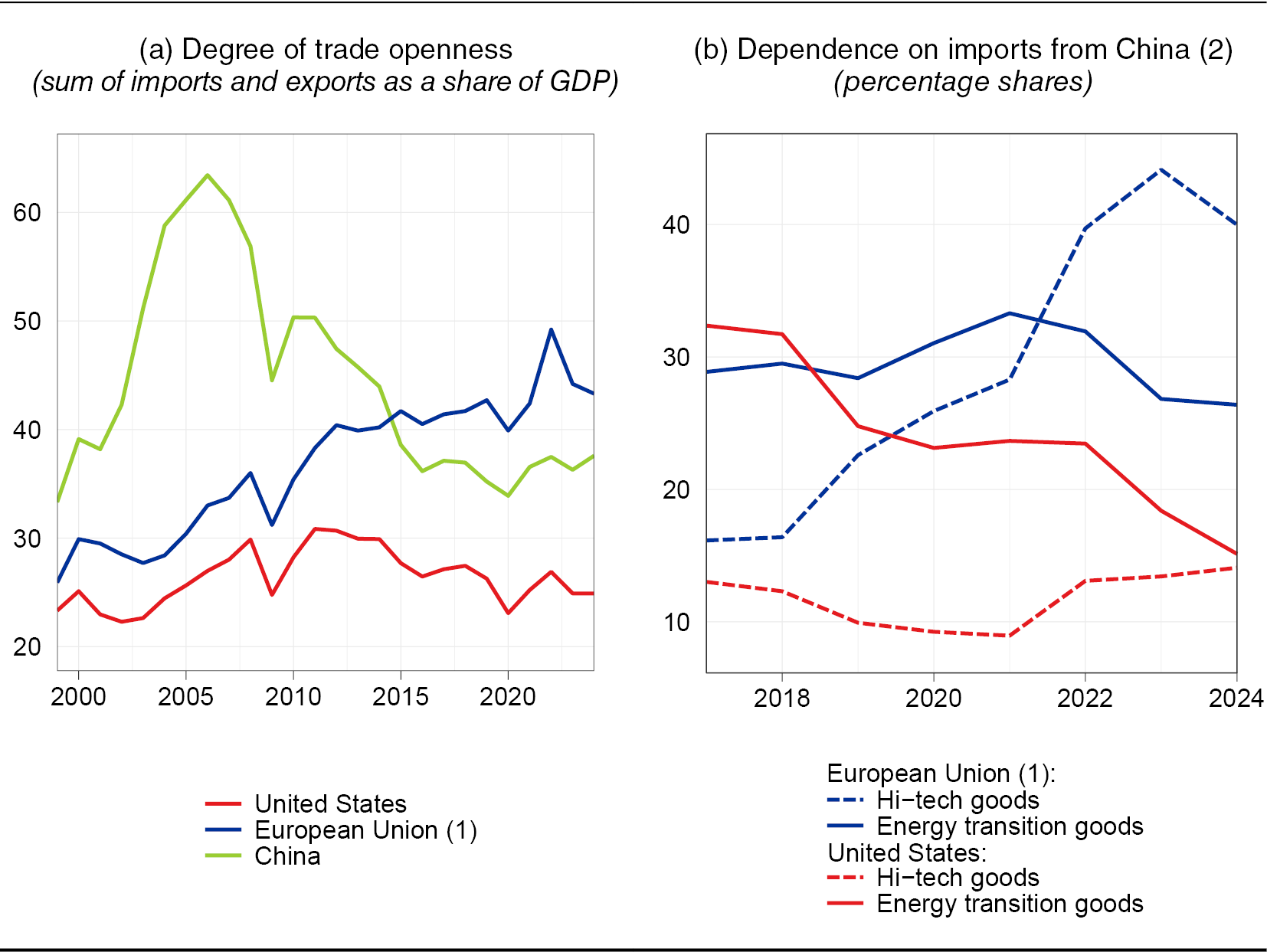
Sources: Eurostat, IMF (World Economic Outlook, April 2025) and based on data from Trade Data Monitor.
(1) The EU data exclude intra-EU trade. - (2) Share of imports from China in total imports.
Manufacturing, services and energy
Manufacturing is still an important component of the European economy, where it accounts for 15 per cent of GDP - 20 per cent in Germany - compared with 10 per cent in the United States. However, competition from the emerging economies has been eroding Europe's competitive edge, including in medium- and high-tech sectors, putting the resilience of entire production chains at risk. China in particular has continued to increase its share of global manufacturing (Figure 6), by leveraging technology, low costs and tight control over value chains.
Figure 6
China, the EU and the US: shares of global manufacturing
(share of global value added)
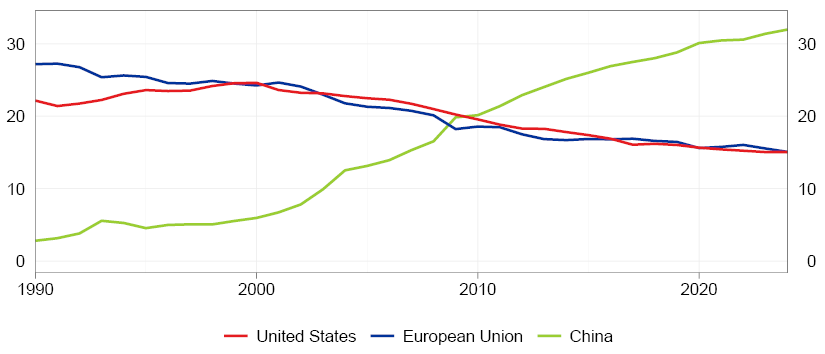
Source: United Nations Industrial Development Organization.
In services, Europe's external surplus - though substantial - stems mainly from traditional sectors such as tourism and transport, while in the United States it is driven by digital specialization.
The issue of high energy costs remains unresolved. Following the invasion of Ukraine, energy costs for European industries have increased significantly, widening the gap with the other major economies. By mid-2024, the cost of electricity in Europe was twice as high as in the US and China and one fifth higher than in Japan.
This disadvantage curbs investment and undermines competitiveness, increasing the risk of firms relocating abroad. Resolute action is needed to reconcile containing energy costs with the decarbonization process. The European Commission has recently provided guidance to that effect.19 However, as I have noted in the past,20 an effective energy transition also requires taking account of its social and production issues, striking the right balance between ambition and feasibility.
Triggering change
The European economy requires swift and structural action. What is needed is an adequately funded reform programme with a clear timeline, based on proposals already put forward at EU level.21
It is necessary to remove the remaining internal barriers to the movement of goods, capital and people, and to invest in technology, common infrastructure and sectors with high growth potential.
In an increasingly unstable global landscape, strengthening strategic autonomy must be a top priority.
The European Commission's Competitiveness Compass22 points in the right direction, but it does not address the crucial issue of how to raise the necessary funds. Several estimates suggest that supporting the green and digital transitions and reinforcing the EU's defence capabilities will require €800 billion per year until 2030.23 This is a sizeable amount, yet it only covers part of the overall financial needs. Making Europe truly competitive will require even greater investments.
A commitment of this scale cannot rely solely on national budgets, nor can it rely on the private sector alone. As I have recently argued, what is needed is a true European 'productivity compact'.24
On the one hand, the public sector is essential for financing European public goods - from energy security to defence and including basic research - and for supporting initiatives that have collective benefits, returns over a long horizon, and at the same time more uncertain outcomes.
On the other hand, mobilizing private capital is key to financing innovative business projects. To do so, we must urgently complete the creation of a fully integrated European capital market, capable of channelling savings towards long-term, risky investments - including through the development of venture capital and private equity funds on a European scale.
This will require regulatory changes,25 to which I will come back shortly. However, eliminating the fragmentation of the capital market along national lines at its root means introducing a European safe asset with a dual purpose: financing the public component of investment and providing a sound and credible common benchmark for the entire financial system.
Our estimates suggest that an integrated capital market, centred on a European safe asset, would lower financing costs for businesses, resulting in additional investment of €150 billion per year and increasing GDP by 1.5 per cent in the long run. The effect on GDP could be up to three times larger if the new investments were directed towards innovative high-tech projects.
This effect would be greater if a single, well-structured and liquid capital market - providing better opportunities for diversification - were able to attract resources from abroad.
The experience of NextGenerationEU shows that it is possible to finance an ambitious European investment plan through the issuance of common public debt without having to create a fiscal union or introduce an EU finance ministry.
Security and defence spending
The new international context has made it clear that Europe needs to step up its defence capabilities. Achieving this goal will require a shared strategy among Member States, a sound common governance framework and sizeable investment.26
The Commission's proposal27 relies on national funding and loans, rather than on European spending and transfers financed using common funds. Such an approach risks widening the disparities between Member States and making spending less effective. What we actually need is a common programme, supported by European debt.
A commitment of this scale must have a clear foundation.
Common resources should be allocated by prioritizing technology and research in defence. At national level, ramping up defence spending should not come at the expense of growth-boosting investments and social expenditure.
Most importantly, promoting international cooperation and peace must remain at the heart of European action.
Investing together in security and defence does not mean entering an arms race, but rather taking a realistic stance in response to common threats that no individual country can tackle alone. Only in this way can security become a pillar of European solidarity: the kind of solidarity that not only protects but also generates prosperity, cohesion and trust.
The Italian economy
I have commented on the Italian economy's long period of stagnation on past occasions.
Over the last five years, however, despite the pandemic and energy crises, the country has displayed signs of a renewed economic vigour.
Growth was greater than in the euro area. GDP grew by about 6 per cent, driven by an increase of almost 10 per cent in the private sector.28 Alongside construction, a significant contribution also came from services, which have been expanding in both the traditional and the advanced sectors. The number of people in employment has increased by around one million, and is now at a historical high of over 24 million, whereas the unemployment rate has fallen from 10 to 6 per cent. The South has grown at a slightly higher rate than the national average.29
Restructuring the production system
These achievements were supported by expansionary economic measures, but would not have been possible without the restructuring of the production system that followed the sovereign debt crisis.30
Between 2013 and 2023, labour productivity in the private sector grew by 0.7 per cent a year on average, and total factor productivity rose by more than 1 per cent, marking a clear improvement compared to the period 2000-13.31
The number of workers employed in medium-sized and large firms has grown significantly and the number of companies with at least 250 employees has risen by one third.32 The adoption of advanced technologies, such as cloud computing, robotics and artificial intelligence, has spread (Figure 7.a).33 Over time, profitability and capital positions have strongly improved (Figure 7.b).
This response by the production system to global changes offers a beacon of hope, but it is just a first step.
Figure 7
New technologies, profitability and leverage of Italian firms
(per cent)
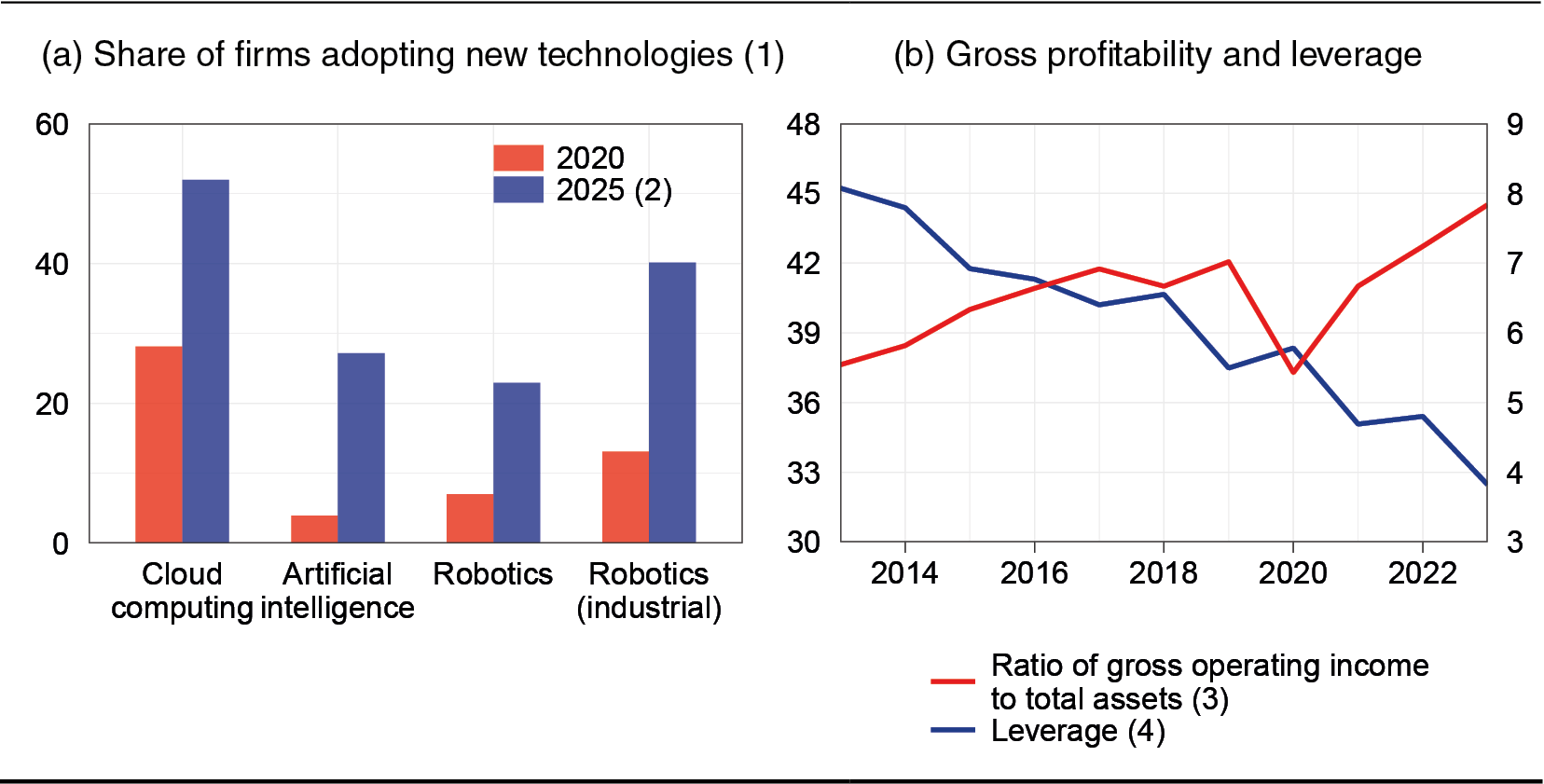
Sources: Calculations based on data from Banca d'Italia (Survey of Industrial and Service Firms; Financial Accounts) and Cerved.
(1) Share of firms with 20 or more employees that reported using each technology on an extensive, limited or only experimental basis. - (2) For cloud computing, the latest figure refers to 2024. - (3) Right-hand scale. - (4) Leverage is calculated as the ratio of financial debts to the sum of financial debts and own funds.
Recent developments and manufacturing
GDP grew by 0.7 per cent in 2024, accompanied by particularly favourable employment conditions. However, labour productivity declined, and so did goods exports.
There was modest growth in domestic demand, with households remaining cautious and limiting the expansion in consumption to 0.4 per cent, in spite of a 1.3 per cent increase in disposable income.
Value added in manufacturing fell by 0.7 per cent, partly as an effect of growing international competition. The remainder of the private sector instead grew by 1 per cent.
In spite of the present challenges, Italian industry is not headed for decline. Dynamic and competitive firms operate in all economic sectors, invest in technology and research, and rank high in their field of production. Having such solid foundations provides a strategic advantage in global competition, but they need strengthening.
Firms need to continue along the path of innovation and investment supported by public policies that enable them to manage the current transformations successfully.
In Italy more than elsewhere in Europe, it is a priority to address energy costs,34 persevering with the course of action already undertaken: making greater use of clean energy sources, incentivizing the use of long-term contracts and strengthening infrastructure and transmission networks.35 Adequate investment and much simpler authorization procedures for new plants are needed.
Yet the central issue is always productivity - in manufacturing as in the rest of the economy. There has been encouraging productivity growth, though it is not enough to support development in Italy.
Low salary levels are a reflection of this weakness. Since the start of the century, mirroring the stagnation in productivity, real wages have grown far less than in the other major European countries: up to the pandemic, wages had grown by a mere 6 per cent. The subsequent inflationary shock drove real wages back to below the 2000 levels, despite the recovery that began last year.
Nevertheless, to ensure a lasting increase in wages, it is essential to boost productivity and growth through innovation, capital accumulation and forceful public action.
Innovation as a strategic lever
Innovation must be at the heart of our economic strategy. This requires far more investment in research and development, in order to bridge the gap that divides Italy from Europe and the United States (Figure 8).
Figure 8
R&D expenditure and funding in Italy
(per cent of GDP)
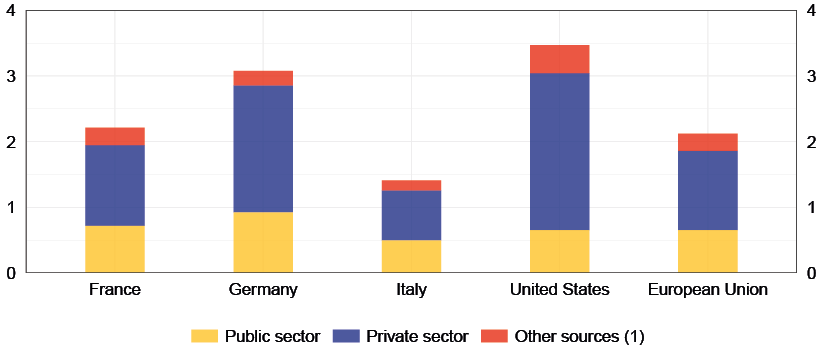
Source: Based on OECD data, 2021.
(1) Includes funding from abroad and expenditure on research by universities using own funds.
The biggest effort here must come from the private sector, whose spending on research and development remains low, a shortcoming that is only partly explained by the prevalence of traditional sectors.
Public action can support innovation by stimulating private research and investment in technology. Public incentives have yielded positive results in the last few years, albeit at a high cost.36 They can become more effective and less costly if they are more targeted and if procedures are simplified.
The quality of scientific research has equalled - and in some sectors overtaken - that of the major European countries, especially in medicine, engineering and IT.37 However, the number of patents remains low, equal to one fifth of German patents and to half of those of France, and they are concentrated in mature sectors. Technology transfer capacity is also still unsatisfactory.38
These failings are mainly a question of resources: average university spending stands at 1.3 per cent of GDP in Europe, but at only 1 per cent in Italy. Closing this gap would be a farsighted investment, achievable with relatively limited resources.
Increasing funds to improve centres of excellence would make the university system more attractive to Italian and foreign researchers, who are currently choosing institutions abroad. Targeted policies for attracting talent could also catch scholars who are leaving other countries.
The National Recovery and Resilience Plan
Public action can support capital accumulation by investing in infrastructure and creating a business-friendly environment. This is the guiding principle behind the National Recovery and Resilience Plan (NRRP).
Italy has received €122 billion under the Plan so far and has used over half of that.39 The disbursement of the upcoming instalments will depend on reaching targets linked to the completion of public works. The information currently available suggests that there are delays.40
The use of NRRP funds has supported the economy in recent years. The measures scheduled over the years 2025-26 could increase GDP by 0.5 per cent: at a time of cyclical weakness, it is essential to be resolute in moving forward with their implementation.
As regards reforms, measures to liberalize markets and simplify administrative procedures have strengthened the economic fabric over the last fifteen years.41 The institutional landscape has improved. The length of trials on contractual issues is down by one third, in part thanks to the organizational reforms to civil justice. Also, the NRRP has promoted the digitalization of the public administration, making public services more accessible and procurement procedures for public works more efficient and transparent.42
Reform efforts require time and continuity, and must continue beyond the end of the NRRP. The priorities remain those set out in the fiscal-structural plan for the next five years:43 improving the business environment and reforming the public administration and the justice and tax systems.
Demographics and the labour force
The ageing of the population and the low birth rate are bound to have a profound effect on the growth potential of Italy's economy. According to Istat, the number of working age people will drop by five million by 2040.44 This could mean an 11 per cent contraction in GDP, an 8 per cent fall in per capita terms.45
An increase in labour market participation rates would soften this effect.46
Greater inclusion of women could help significantly; despite recent progress, their participation rate is among the lowest in Europe.47 Investments in childcare services encourage female employment, which is still hindered by a lack of adequate facilities and an unbalanced distribution of family responsibilities.
However, even under the most favourable scenario, higher participation rates will at best offset the fall in the working-age population.
In order to expand the labour force in a stable way, attractive employment opportunities need to be created for the many Italians who leave the country in search of better prospects. Some 700,000 Italians have emigrated in the last ten years, a fifth of whom are young graduates.48
Legal immigration can make a significant contribution, especially in the construction and tourism sectors, which are experiencing a growing shortage of labour.49
This contribution could extend to higher value-added activities, provided that skilled workers can be attracted.50 Italy lags behind on this front: among the leading countries, it has the lowest share of immigrant graduates (Figure 9). Narrowing this gap entails - among other things - aligning the system for recognizing academic degrees and professional qualifications in line with European standards.
Figure 9
Distribution of the resident population aged 25-64 born abroad by educational attainment
(per cent)
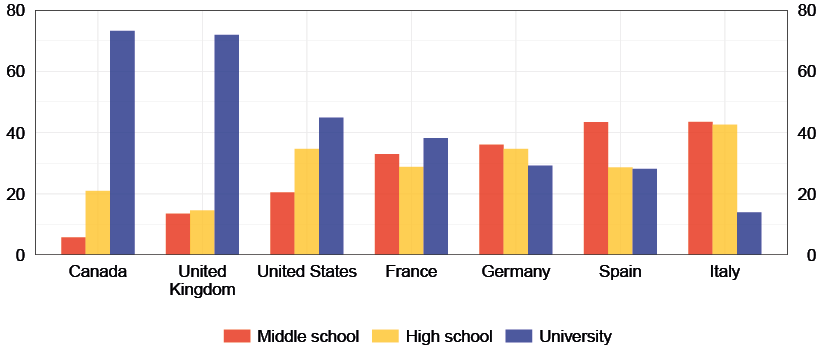
Sources: Based on Eurostat and OECD data, 2023.
The public finances
Compared with 15 years ago, when the assessments of the main rating agencies on Italy's public debt began to worsen, the fundamentals of our economy have greatly improved.
The net international investment position, which was negative by 20 percentage points of GDP, is positive by 15 points today. The banking system is significantly more robust, which has a significant impact on agencies' ratings.
The resolution of the pandemic and energy crises has made it possible to end the phase of extraordinary budget measures, thus improving the public accounts. The deficit fell to 3.4 per cent of GDP in 2024 and a primary surplus was recorded for the first time since 2019.
This progress was reflected in the positive assessments recently published by rating agencies.
However, the process of fiscal consolidation is only at the beginning. Debt remains high and expenditure will come under pressure in the next few years owing to an ageing population, the green and digital transitions, and the scaling up of our defence capacity.
The new European rules have restored a medium-term horizon to fiscal policy, thereby helping to anchor investors' expectations. The medium-term fiscal-structural plan, published last autumn, sets out a path for debt reduction in line with this new approach. The public finance document for 2025, approved in April, confirmed that we are heading in that direction.
It is crucial to ensure continuity along this path, even in the event of a weakening macroeconomic outlook. The progress achieved in recent years must prompt us to maintain a prudent fiscal policy and to intensify the reform efforts needed to support growth.
Economic growth and the sustainability of the public finances are interdependent. Confidence in the soundness of public finances encourages investment, and higher growth in turn makes fiscal consolidation less of a burden.
Banks and financial markets
The Italian banking system
Balance sheet data and market valuations confirm that the Italian banking system is on solid footing.
The cost-to-income ratio continues to improve. Net interest income is starting to be negatively affected by falling interest rates, but profitability is being supported by fee income, especially on asset management activities. Return on equity remains high and the outlook is stable.
Small banks, which are more vulnerable to the squeeze on net interest income, nevertheless enjoy a relatively satisfactory return on equity of around 8 per cent.51
Capitalization is robust for the system as a whole and exceeds the European average. The price-to-book ratio for listed banks remains well above one (Figure 10).
Figure 10
Price-to-book ratio of the main listed banks
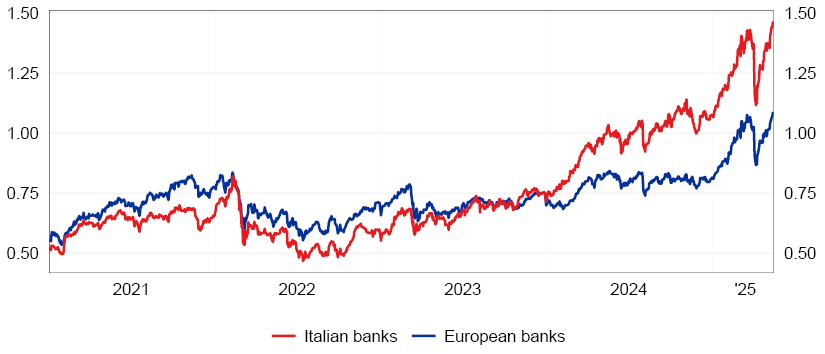
Source: Based on LSEG data.
According to our estimates, the flow of non-performing loans to firms will continue to grow moderately over the next two years. Trade tensions could affect credit risk, but the impact should be limited overall.52 In any case, high profitability and the built-up capital buffers have prepared the Italian banking system to absorb possible shocks.
Banca d'Italia continues to monitor the situation closely and stands ready to take action where needed. Over the last few months, the Bank has intervened in several cases in which small banks found themselves in difficulty, mainly owing to corporate governance and internal control system deficiencies.
Trends in lending
Over the last year, lending to firms continued to decline, albeit at a slower pace. This development warrants attention: adequate availability of credit is essential to support investment and revive production - especially for small firms, who find it more difficult to access alternative funding sources.
The available evidence suggests, however, that the contraction in lending to firms primarily reflects weak demand, rather than a tightening of credit supply conditions.
Business surveys show that the share of firms that report difficulties in accessing credit is declining across all sectors and all size classes.
This finding is consistent with firms' balance sheet data. In recent years, internal financing has grown more than investment (Figure 11.a), including for small firms, thereby progressively reducing - and eventually eliminating - the need for external funding (Figure 11.b).
Figure 11
Internal financing, investment and financing needs of Italian firms
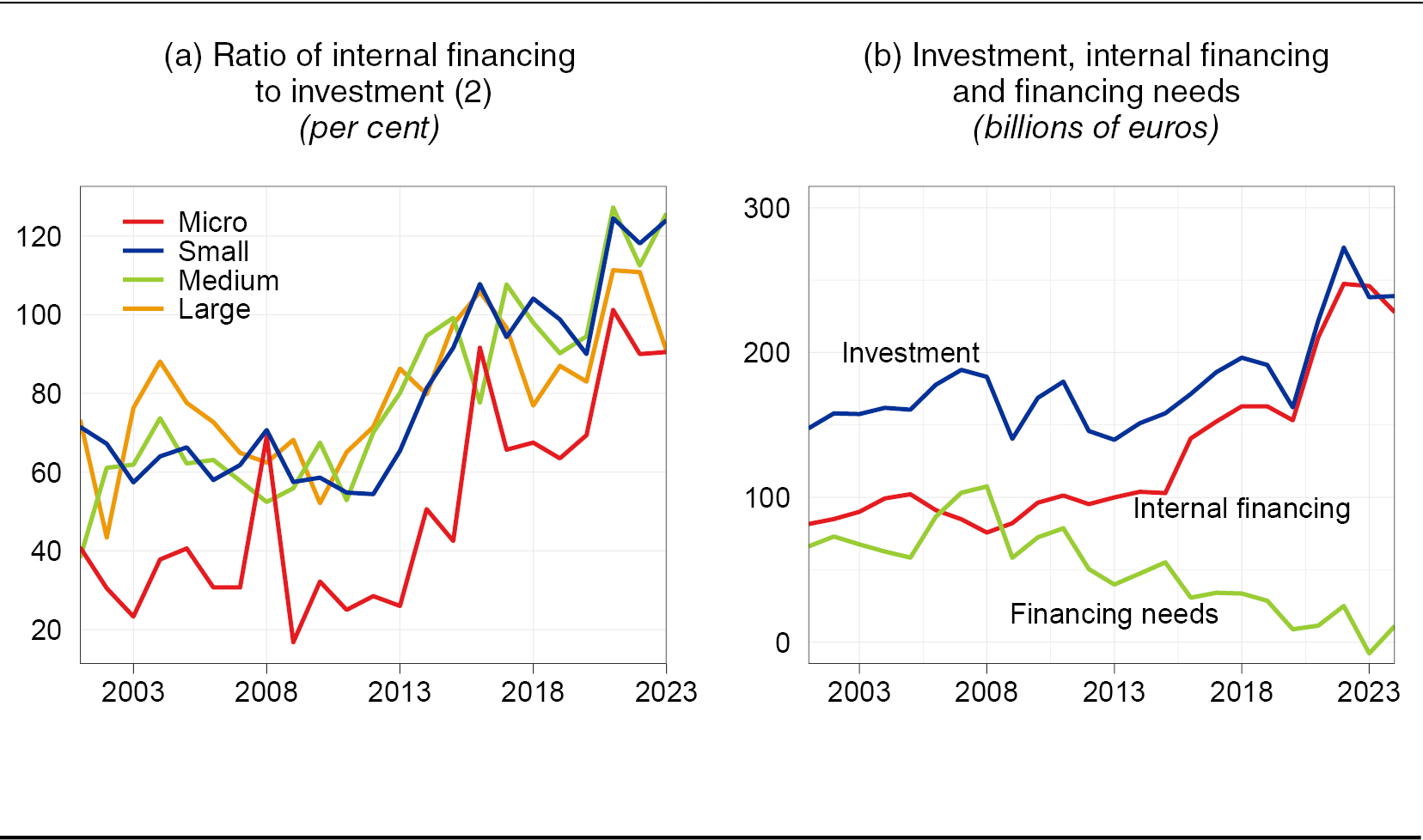
Sources: Banca d'Italia, Istat and Cerved.
(1) Annual flows, nominal values. - (2) The data refer to a sample of about 800,000 limited companies.
At the same time, many firms have substantially increased their capital53 and expanded their reserves of financial assets. As I have already mentioned, leverage has improved considerably since the sovereign debt crisis.
Banca d'Italia will continue to follow developments in lending, especially in the case of small firms.
Consolidations
In recent months, several complex consolidation transactions have been announced, sometimes in competition with one another, that involve banks of different sizes and business models, insurance companies and asset managers.
For some of these transactions, the investigation phase has ended, while for others it is still under way.
Three years of robust profits have made significant resources available to banks, which are now being used to launch initiatives that would reduce the fragmentation of the Italian credit market, thereby bringing its degree of concentration closer to that of the other main European countries.
Acquisitions can be a delicate moment and mark a break in the life of intermediaries. Their goal must be to strengthen them, which is why they must be well-designed and aimed solely at value creation.
Creating value means, first and foremost, offering firms and households adequate financing in terms of quantity and costs; effective and transparent savings instruments at fair conditions; qualified and innovative services, consistent with Italy's development needs.
As part of its mandate, Banca d'Italia is involved in the transaction approval processes in close cooperation with the ECB and IVASS. Other national and foreign authorities operate in accordance with their statutory powers.
Banca d'Italia is responsible for verifying that each transaction complies with Italian and EU prudential legislation, and that the resulting intermediaries are sound in terms of capital, liquidity and risk governance.
Provided these conditions are met, the judgment on each offer is ultimately determined by market dynamics and shareholder decisions.
Simplifying the regulatory framework
The newly-elected US administration has taken a favourable stance towards the deregulation of the banking and financial sectors. This also raises questions for the European Union, which needs to consider whether and how to respond so as not to be placed at a competitive disadvantage.
There are good reasons why Europe should not go down the same path.
Weakening the regulatory framework in an environment of increasing risks would be imprudent. Maintaining an effective regulatory framework that staves off instability and preserves the soundness of the system is crucial.
The rules introduced in response to the global financial crisis have proved effective. They have helped European banks withstand major shocks - from the pandemic to the energy crisis - while remaining strong. Conversely, the failure of a few US regional banks in the spring of 2023 can be partly explained by the non-application of some international prudential standards.
Moreover, European banks have been showing highly positive capital and income results for years, proof that well-designed regulations can safeguard stability without sacrificing competitiveness and efficiency.
The aim must therefore not be to relax the rules but rather to improve them.
The focus should be on simplification, thereby eliminating regulatory overlaps and ambiguities and lightening the administrative burden.54 A clearer and more consistent regulatory framework would reduce uncertainty for operators and make supervisory action more effective and timely.
In Europe, simplification must start by harmonizing the legislation across EU Member States, so that operators active in multiple markets do not have to comply with different rules. In the banking sector, the goal must be to have a coherent EU legislative framework based on a consolidated banking law for all the Member States.
Intervention should help achieve the objectives of the regulations, preserving the levels of capital and liquidity achieved so far. It should cover all regulatory levels55 and the main scopes of application: from macroprudential oversight and the supervision of financial intermediaries, to crisis management and resolution.
Simplification is one of the European Commission's priorities for this legislative term and is part of its strategy to boost the EU's competitiveness.56
The initiatives recently announced by the Commission57 to develop securitizations, facilitate the cross-border activity of investment funds and boost investment in venture capital go in the right direction and can foster the creation of a genuine European capital market.
Banca d'Italia is involved in the discussions on these issues within the Eurosystem and in cooperation with the Ministry of Economy and Finance and the European Commission.
Crypto-assets
The link between the world of crypto-assets and the financial system are growing ever stronger at international level. Agreements between crypto-asset players and financial intermediaries are on the rise, and so are initiatives launched by the latter. Some US listed companies have purchased large amounts of Bitcoin, thereby exposing their shares - and indirectly savers - to the volatility of this instrument. Furthermore, exchange traded funds (ETFs) that invest in Bitcoin have been operating for some time.
These developments have implications for risk.
First, crypto-assets such as Bitcoin, which are not backed by an underlying asset, are highly volatile and are mostly traded on unregulated, opaque exchanges. Their growing interconnectedness with the financial system makes it more difficult to contain the related risks, as I have already discussed on previous occasions.58
Second, there is the matter of stablecoins. These instruments are designed to maintain a stable value against underlying currencies or assets, but still expose holders to risks relating to the soundness of the issuers and to volatility in the value of the underlying asset. In the absence of adequate regulation, their suitability as a means of payment is doubtful, to say the least.
However, if large foreign-based technology platforms decided to promote the use of stablecoins for payments between their customers, this could lead to new systemically important payment schemes operating on a global scale. Traditional means of payment used domestically - such as banknotes and cards - could be crowded out, negatively affecting monetary sovereignty, personal data protection, and credit intermediation, which so far has always been integrated with and complementary to the provision of payment services.
One risk that cuts across all crypto-assets is that of illicit use. As these technologies allow anonymous transactions, they lend themselves to being used for activities such as money laundering, arms or drug trafficking and the circumvention of international sanctions.59
Several countries have started regulating crypto-assets. China decided to ban their use. Conversely, the US administration has taken a favourable stance, though the regulatory framework is still a work in progress.60
In Europe, the Markets in Crypto-assets Regulation (MiCAR) introduced rules to protect customers and facilitate the orderly development of the market.61 MiCAR divides stablecoins into two categories: only those pegged to a single currency - known as electronic money tokens (EMTs) - offer consumers sufficient safeguards to qualify as a means of payment, including the right to redeem them at nominal value.
Since MiCAR came into force, only some EMT stablecoins have been issued in the EU and their circulation is limited so far. Many operators reported they had started providing crypto-asset services, or were intending to apply for authorization to do so.
In Italy, there has so far been little interest in the issuance of crypto-assets by supervised intermediaries and other operators, while a growing focus on custodial and trading services has been observed.
The risks that stem from this sector will have to be monitored carefully, especially the reputational risks linked to the provision of crypto-assets by banks. In fact, there is a concern that crypto-asset holders might not fully understand their nature and conflate them with traditional banking products, with potentially negative repercussions for confidence in the credit system should losses occur.
Overall, MiCAR offers protection to European savers. However, heterogeneity in regulatory approaches at international level remains a source of risk. EU citizens might be exposed to failures of platforms or issuers based in other jurisdictions that lack adequate controls or the necessary transparency and operational safeguards.
These risks can be contained through international cooperation - an objective for which Europe could take the lead.
But we would be remiss to think that the evolution of crypto-assets can be controlled only through rules and restrictions.
What is needed is a response that matches the ongoing technological transformation, one capable of meeting the demand for secure, efficient and accessible digital payment instruments, all while preserving the role of central bank money. The digital euro project stems precisely from this need.
At the same time, strengthening financial literacy is essential to help people navigate the new digital landscape and make informed decisions about the opportunities and risks that come with these products and services.
Banca d'Italia is engaged on both of these fronts.
Conclusions
New countries have emerged on the global stage, propelled by market integration throughout the long period of economic stability following the end of the Cold War.
In 2000, G7 economies accounted for almost half of the world's GDP; today, they generate less than one third. Technology is no longer the exclusive domain of advanced countries.
The importance gained by the emerging economies was bound to shift the existing balance.
Globalization has driven world growth and lifted more than two billion people out of poverty, but not everyone has benefited fully. What has followed is a widespread sense of disenchantment, heightened by a dramatic sequence of crises over the last two decades.
Today's bitter trade disputes are not a passing malaise. They are symptoms of a fraying of international political and economic relations, which has accelerated the reorganization of global supply chains and of trade flows that was already under way.
Digital innovation is unfolding before our very eyes. It can and should become a driving force for productivity again, which otherwise risks stagnating in advanced countries. We must not fear it.
Yet, like any technological revolution, the one we are currently experiencing will reshape our economies. It will only be sustainable if we can benefit from it by making it inclusive, mitigating its risks and protecting the weak.
The repercussions of these developments on the global economy are difficult to foresee. Even the role of the dollar, long the linchpin of the international monetary system, is now being questioned. Uncertainty is widespread.
The multilateral system - unbalanced and imperfect as it was - sought to address global challenges through shared rules and common principles. That system is now in crisis. In its place, a multipolar order is taking shape, one in which power dynamics carry increasing weight.
Even the historically close relationship between the US and Europe is feeling the strain. Yet the cultural affinities and economic ties that unite us must ultimately prevail over the current frictions.
We must get ready to navigate these uncertain waters, without giving up our values, and without falling behind.
The European Union remains a bastion for the rule of law, democratic coexistence and openness to trade and international cooperation, but it cannot afford to stand still. It must rise above national divisions and convert its economic strength - and its rich heritage of culture and values - into political clout.
I have often argued that a common European response is key to overcoming today's challenges. The agenda is well-known, and the path is already mapped out.
There is now an unavoidable need, but also a real possibility, to complete the common market; to simplify, but not dismantle, the rules that govern it; and to create a unified capital market centred on the regular issuance of European bonds. This would help generate the public and private resources needed to finance investment and foster growth.
It is just as important to preserve and strengthen the pillars of the European social model. Our social welfare systems, based on the principle of solidarity, are preconditions for development and cornerstones of European civil society.
Italy will also benefit from a decisive common European response.
The challenges of growth and innovation now facing Europe emerged earlier - and more markedly - in Italy. We bear the burden of longstanding structural weaknesses that we have not yet overcome: regional disparities, low education levels, a fragmented production system, and persistent barriers to innovation. For forty years now, we have shouldered a heavy public debt that restricts our investment capacity and constrains economic policies.
Yet, in the aftermath of the global financial and sovereign debt crises, we are seeing signs of change: in manufacturing and services, in the financial sector, in the public administration and in research. These are signs of vitality that we must not fritter away.
These achievements are unfinished, but they mark real progress. They provide a concrete foundation on which to build - through reforms, by dismantling entrenched privileges, and by giving young people a future they can believe in.
We have both the responsibility and the opportunity to do this.
Endnotes
- 1 Globally, over 50 per cent of trade transactions (excluding those within the euro area) and some 60 per cent of foreign currency reserves are denominated in US dollars.
- 2 Without the progress made over the last 35 years, 2.4 billion more people would be living in poverty today; see F. Panetta, 'Peace and prosperity in a fragmented world', speech at the event 'Economy and Peace: a possible alliance', Bologna, 16 January 2025.
- 3 The US trade deficit is the main cause of the current account deficit, which, in accounting terms, corresponds to the net capital inflow. In general, holding GDP constant, a narrowing in the trade deficit must be offset accounting-wise by a decrease in either consumption or investment; see M. Obstfeld and K. Rogoff, 'The six major puzzles in international macroeconomics: is there a common cause?', in B.S. Bernanke and K. Rogoff (eds.), NBER Macroeconomics Annual 2000, 15, Cambridge, MA, The MIT Press, 2001, pp. 339-390.
- 4 In the last 20 years, international trade costs for services have fallen by between 30 and 60 per cent, largely as a result of technological progress; see L. Patrignani, 'Understanding digital trade', Banca d'Italia, Questioni di Economia e Finanza (Occasional Papers), 841, 2024.
- 5 Empirical analyses point to a positive relationship between international trade in services and productivity growth, both in importing and exporting countries; see M. Amiti and S.-J. Wei, 'Service offshoring and productivity: evidence from the US', The World Economy, 32, 2, 2009, pp. 203-220; J. Perla, C. Tonetti and M.E. Waugh, 'Equilibrium technology diffusion, trade, and growth', American Economic Review, 111, 1, 2021, pp. 73-128.
- 6 Low-income countries are those eligible for concessional financing from the World Bank.
- 7 For further details, see the box 'The debt situation in low-income countries', Chapter 1, Annual Report for 2024, 2025.
- 8 According to the IMF and the World Bank, more than half of low-income countries are 'in debt distress' or 'at high risk of debt distress'.
- 9 Euro-area GDP expanded by 0.9 per cent in 2024, against an estimated potential growth rate of 1.2 per cent; see European Commission, European Economic Forecast. Spring 2025, May 2025.
- 10 The existing tariffs are estimated to lead to an increase in Chinese exports to the euro area of around 2.5 per cent over the next two years, with a negative impact on inflation of 0.1 percentage points. These effects could be three times greater if the ongoing negotiations were to fail and the tariffs currently on hold were to be reinstated.
- 11 F. Panetta, 'Economic developments and monetary policy in the euro area', speech at the 30th ASSIOM FOREX Congress, Genoa, 10 February 2024.
- 12 F. Panetta, 'The ECB must remain pragmatic in setting rates', Financial Times, 26 March 2025.
- 13 The gap is also significant in total factor productivity, which has grown by 37 per cent in the United States and by 25 per cent in Europe.
- 14 In 2023, US firms' spending on research and development amounted to 2.7 per cent of GDP, compared with 1.5 per cent for European firms.
- 15 F. Panetta, 'If we are not after the essence, then what are we after?', speech at the 45th Foundation Meeting for Friendship among Peoples, Rimini, 21 August 2024. C. Fuest, D. Gros, P.-L. Mengel, G. Presidente and J. Tirole, 'EU innovation policy: How to Escape the Middle Technology Trap', EconPol Policy Report, 2024.
- 16 Horizon Europe, the European Union's framework programme for research and innovation for the period 2021-27, has just €13.4 billion a year available in funding, i.e. just over 10 per cent of the total expenditure of the Member States.
- 17 In 2023, China accounted for one third of global scientific research output, four times more than fifteen years prior. In the same year, the United States and Europe each produced one fifth of total quality research. Quality scientific research publications are defined as the top 10 per cent of papers by number of citations, according to Scopus Custom Data and SCImago Journal Rankings data; see OECD, OECD bibliometric indicators. Selected highlights, May 2025.
- 18 F. Panetta, 'Monetary autonomy in a globalised world', welcome address at the joint BIS, BoE, ECB and IMF conference on 'Spillovers in a "post-pandemic, low-for-long" world', Frankfurt, 26 April 2021.
- 19 European Commission, 'Action Plan for Affordable Energy. Unlocking the true value of our Energy Union to secure affordable, efficient and clean energy for all Europeans', COM(2025) 79 final, 26 February 2025. The Action Plan proposes action on: cost components affecting end-users; markets, instruments and contracts for the purchase of electricity; and the investments needed to upgrade the existing infrastructure.
- 20 F. Panetta, 'The heat is on: challenges and opportunities of the energy transition', opening remarks at the G7-IEA conference on 'Ensuring an orderly energy transition', Rome, 16 September 2024.
- 21 E. Letta, 'Much more than a market: speed, security, solidarity. Empowering the Single Market to deliver a sustainable future and prosperity for all EU Citizens', April 2024; M. Draghi, 'The future of European competitiveness', September 2024.
- 22 European Commission, 'A Competitiveness Compass for the EU', COM(2025) 30 final, 29 January 2025.
- 23 F. Panetta, 'Investing in Europe's future: The case for a rethink', speech delivered at the Istituto per gli Studi di Politica Internazionale (ISPI), Milan, 11 November 2022; O. Bouabdallah, E. Dorrucci, L. Hoendervangers and C. Nerlich, 'Mind the gap: Europe's strategic investment needs and how to support them', The ECB Blog, 27 June 2024. M. Draghi, 2024, op. cit.
- 24 F. Panetta, 'A European productivity compact', speech at the 20th Spain-Italy Dialogue Forum (AREL-CEOE-SBEES), Barcelona, 3 December 2024.
- 25 European Commission, 'Savings and Investments Union. A Strategy to Foster Citizens' Wealth and Economic Competitiveness in the EU', COM(2025) 124 final, 19 March 2025.
- 26 For further details, see the box 'Defence spending in EU countries', Chapter 2, Annual Report for 2024, 2025.
- 27 The European Commission's proposal is the 'ReArm Europe/Readiness for 2030' plan; see 'President von der Leyen will hold Strategic Dialogue on Steel on 4 March, and announces Steel and Metals Action Plan', press release by the President of the European Commission, Ursula von der Leyen, 25 February 2025; European Commission and the High Representative of the European Union for Foreign Affairs and Security Policy, 'Joint white paper for European defence readiness 2030', JOIN(2025) 120 final, 19 March 2025.
- 28 The figure indicates growth in value added in the non-farm, non-financial private sector, net of real estate services.
- 29 F. Panetta, 'Eppur si muove: l'economia del Mezzogiorno dopo la crisi', speech at the 'Il polso dell'economia: il Mezzogiorno' event, Catania, 19 September 2024 (only in Italian).
- 30 As well as raising GDP growth by 1 percentage point for the period 2019-23, the recent review of national accounts also gave higher figures for firms' productivity growth.
- 31 Between 2000 and 2013, labour productivity stagnated and total productivity fell by half a percentage point per year.
- 32 A. Accetturo et al., 'Le recenti dinamiche della produttività e le trasformazioni del sistema produttivo', Banca d'Italia, Questioni di Economia e Finanza (Occasional Papers), forthcoming (only in Italian).
- 33 For further details, see the box 'The use of artificial intelligence by Italian firms', Chapter 6, Annual Report for 2024, 2025.
- 34 The cost of electricity to firms in Italy in 2024 was 25 per cent higher than the European average. (Based on Eurostat data; Electricity prices components for non-household consumers - annual data).
- 35 Since 2022, Italy has seen a significant acceleration of new renewable energy installations, after eight years of modest growth. Firms are making increasing use of long-term electricity purchase agreements and the system operator has promoted new types of contracts. The development plan recently presented by Terna contains numerous measures to increase the capacity and resilience of the electricity transmission network. For further details, see M. Alpino et al., 'Going green: the recent development of renewable energy sources in Italy', Banca d'Italia, Questioni di Economia e Finanza (Occasional Papers), 908, 2025. Italy has taken measures that are in line with recent European Commission guidelines.
- 36 Ministry of Economy and Finance, Banca d'Italia and Ministry of Enterprise and Made in Italy, 'Gli incentivi in investimenti 4.0: una valutazione dell'impatto della misura', 2024 (only in Italian).
- 37 For more details, see the box 'The innovation system in Italy: an international comparison', Chapter 6, Annual Report for 2024, 2025.
- 38 Italy's most active university handles barely one third of the patents of the leading German university and one quarter of those of the French equivalent.
- 39 Our country ranks fifth in terms of both the share of payments received and of completed milestones and targets. The countries that have done better have much smaller plans. These include France and Germany, with an allocation of funds amounting to €40 and €30 billion respectively.
- 40 For further details, see Ministry for European Affairs, the NRRP and Cohesion Policies, Sesta Relazione al Parlamento sullo stato di attuazione del Piano nazionale di Ripresa e Resilienza, 27 March 2025, and the box 'The state of progress of the National Recovery and Resilience Plan (NRRP)', Chapter 4, Annual Report for 2024, 2025.
- 41 E. Ciapanna, S. Mocetti and A. Notarpietro, 'The macroeconomic effects of structural reforms: an empirical and model-based approach', Economic Policy, 38, 114, 2023, pp. 243-285; A. Cintolesi, S. Mocetti and G. Roma, 'Productivity and entry regulation: evidence from the universe of firms', Banca d'Italia, Temi di Discussione (Working Papers), 1455, 2024.
- 42 For further details, see the box 'An indicator of the quality of the institutional environment', Chapter 11, Annual Report for 2024, 2025 (only in Italian).
- 43 'Medium-term Fiscal-Structural Plan. Italy 2025-2029', approved by the Italian Parliament on 9 October 2024.
- 44 Istat, Population and household projections. Base 1/1/2023, Statistics report, 24 July 2024. Median scenario.
- 45 The effect of the demographic decline on GDP is calculated assuming that productivity and the employment rate by gender and age group remain unchanged at 2024 levels.
- 46 'Parliamentary commission of inquiry into the economic and social effects stemming from the ongoing demographic transition', testimony by Andrea Brandolini, Deputy Director General of Economics, Statistics and Research at Banca d'Italia, Chamber of Deputies, Rome, 15 April 2025 (only in Italian).
- 47 In 2024, the female participation rate was 57.6 per cent in Italy.
- 48 'Parliamentary commission of inquiry into the economic and social effects stemming from the ongoing demographic transition', testimony by Francesco Maria Chelli, President of Istat, Chamber of Deputies, Rome, 1 April 2025 (only in Italian).
- 49 According to estimates based on Istat data, the job vacancy rate in construction and in tourism in the last five years was about 3 per cent, or just under 70,000 jobs per year.
- 50 The attractiveness of other major destination countries also depends on simpler procedures for validating the qualifications and skills acquired by migrants in their country of origin; see G. Basso, E. Gentili, S. Lattanzio and G. Roma, 'Migration flows and policies in Italy and in other European countries', Questioni di Economia e Finanza (Occasional Papers), 923, 2025.
- 51 'Small banks' here means those that are referred to as 'less significant institutions' in European supervisory parlance, and specifically those with a traditional business model.
- 52 For more details, see the box 'The exposure of the euro-area banking system to the sectors most vulnerable to US tariffs', Financial Stability Report, 1, 2025.
- 53 Between 2011 and 2024, the cumulative flow of capital increases by firms amounted to around €280 billion; over the same period, the overall value of own funds rose from 84 to 121 per cent of GDP.
- 54 Joint letter from the Governors of Banca d'Italia, Banco de España and Banque de France, and the President of Deutsche Bundesbank to the EU Commissioner for Financial Services and the Savings and Investments Union, 5 February 2025.
- 55 These include: primary legislation (Level 1), delegated acts (Level 2) and the guidelines developed by the European supervisory authorities (Level 3).
- 56 European Commission, 'A Competitiveness Compass for the EU', 2025, op. cit., and European Commission, 'A simpler and faster Europe: Communication on implementation and simplification', COM(2025) 47 final, 11 February 2025.
- 57 European Commission, 'Savings and Investments Union. A Strategy to Foster Citizens' Wealth and Economic Competitiveness in the EU', 2025, op. cit.
- 58 F. Panetta, 'Banks and the economy: credit, regulation and growth', speech delivered at the Annual Meeting of the Italian Banking Association (ABI), Rome, 9 July 2024.
- 59 Between 2020 and 2024, transactions in crypto-assets linked to criminal activity amounted to about $200 billion.
- 60 In the United States, a number of measures are being considered with a view to ensuring the stability of crypto-asset players and protecting customers' rights; see the box 'Developments in the crypto-assets market and the risks to financial stability', Financial Stability Report, 1, 2025.
- 61 Issuers of crypto-assets and entities offering services relating to these instruments are subject to a number of requirements relating to capital, governance, asset segregation, transparency and customer protection. MiCAR also introduced rules to combat the use of crypto-assets for illicit purposes.


 YouTube
YouTube
 X - Banca d'Italia
X - Banca d'Italia
 Linkedin
Linkedin
